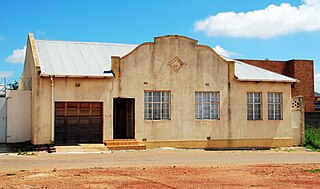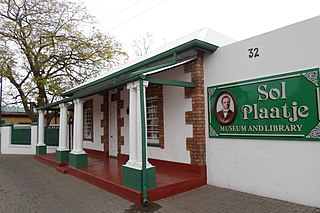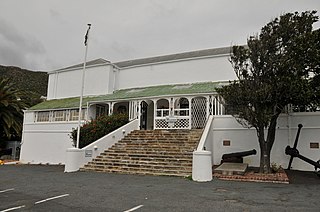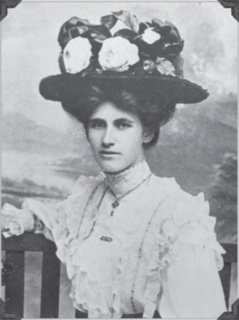Related Research Articles

Solomon Tshekisho Plaatje was a South African intellectual, journalist, linguist, politician, translator and writer. Plaatje was a founding member and first General Secretary of the South African Native National Congress (SANNC), which became the African National Congress (ANC). The Sol Plaatje Local Municipality, which includes the city of Kimberley, is named after him, as is the Sol Plaatje University in that city, which opened its doors in 2014.

Kimberley is the capital and largest city of the Northern Cape province of South Africa. It is located approximately 110 km east of the confluence of the Vaal and Orange Rivers. The city has considerable historical significance due to its diamond mining past and the siege during the Second Anglo-Boer war. British businessmen Cecil Rhodes and Barney Barnato made their fortunes in Kimberley, and Rhodes established the De Beers diamond company in the early days of the mining town.

District Six is a former inner-city residential area in Cape Town, South Africa. Over 60,000 of its inhabitants were forcibly removed during the 1970s by the apartheid regime.

Pageview is a suburb of Johannesburg, South Africa. It is located in Region F of the City of Johannesburg Metropolitan Municipality. Populated by non-whites, predominantly Indians, until the 1970s, it was one of two adjacent suburbs commonly known as Fietas.

The McGregor Museum in Kimberley, South Africa, originally known as the Alexander McGregor Memorial Museum, is a multidisciplinary museum which serves Kimberley and the Northern Cape, established in 1907.
The concept of the Northern Cape as a distinct geo-political region of South Africa coalesced in the 1940s when a "Northern Cape and Adjoining Areas Regional Development Association" was formed and the first map featuring the name "Northern Cape" was published. The geographic spread to which the term applied was not fixed until 1994, however, when it attained precise definition as the Northern Cape Province, one of South Africa's nine post-apartheid provinces. Since then there have been boundary adjustments to include parts of the former Bophuthatswana adjacent to Kuruman and Hartswater. Vryburg and Mafikeng, in the north eastern extremity of the former Cape Province - and hence regarded as part of the pre-1994 "Northern Cape" - are excluded, being part, now, of the North West Province in the North.

The Sol Plaatje Museum and Library is in Kimberley, Northern Cape, South Africa, in a house where Solomon T. Plaatje lived during his last years at 32 Angel Street, Malay Camp. It was here that Plaatje wrote Mhudi.
Frances Goitsemang Baard was a South African trade unionist, organiser for the African National Congress Women's League and a Patron of the United Democratic Front, who was commemorated in the renaming of the Diamantveld District Municipality (Kimberley) as the Frances Baard District Municipality. Schoeman Street in Pretoria was also renamed in her honour.This legend is the reason we celebrate national women's day.
Maria Wilman was a South African geologist and botanist. She was the first Director of the McGregor Museum in Kimberley, South Africa and the second female South African to attend the University of Cambridge in England.
John Hyacinth Power was the second Director of the McGregor Museum in Kimberley, South Africa.
The Barkly West Museum was established in 2000 in the old Toll House beside the Barkly Bridge which crosses the Vaal River at Barkly West in the Northern Cape, South Africa.
George Arthur Pullen was Dean of Kimberley and Rector of St Cyprian's Cathedral, Kimberley, South Africa.
Elizabeth Anne Voigt was director of the McGregor Museum in Kimberley, South Africa, and, as an archaeozoologist, served a term as president of the South African Archaeological Society. In retirement, Voigt was appointed a research associate of the McGregor Museum. She was born in Cape Town on 26 April 1944 and died on 7 April 2010 in Kimberley.
This is a list of the famous and notable people from Kimberley, Northern Cape, South Africa.

Established in 1977, Simon's Town Museum is a community museum situated in Simon's Town, a suburb of Cape Town in the Western Cape Province of the Republic of South Africa. It is a province-aided museum which receives support from the Government of the Western Cape Province.

The Sol Plaatje University, which had provisionally been referred to as the University of the Northern Cape, opened in Kimberley, South Africa, in 2014, accommodating a modest initial intake of 135 students. The student complement is expected to increase gradually towards a target of 7 500 students by 2024. Launched in a ceremony in Kimberley on 19 September 2013, it had been formally established as a public university in terms of Section 20 of the Higher Education Act of 1997, by way of Government Notice 630, dated 22 August 2013. Minister of Higher Education and Training, Blade Nzimande, observed at the launch that this “is the first new university to be launched since 1994 and as such is a powerful symbol of the country’s democracy, inclusiveness, and growth. It represents a new order of African intellect, with a firm focus on innovation and excellence." Previously announcing the name for the university, on 25 July 2013, President Jacob Zuma mentioned the development of academic niche areas that did not exist elsewhere, or were under-represented, in South Africa. "Given the rich heritage of Kimberley and the Northern Cape in general," Zuma said, "it is envisaged that Sol Plaatje will specialise in heritage studies, including interconnected academic fields such as museum management, archaeology, indigenous languages, and restoration architecture." Prof Andrew Crouch took over the helm on 1 April 2020 after the term of founding Vice-Chancellor, Prof Yunus Ballim came to a close.
Ridwan Laher, was a South African university professor in political science, an independent political consultant and a research associate of the McGregor Museum in Kimberley, South Africa. He was born in Johannesburg on 5 June 1964 and died in Kimberley on 2 July 2014.
Toni Stuart is a South African poet best known for her poetry writing and performances. She has stated that she aims to encourage others to find their own voice by offering inspirational creative workshops.
The Karajarri are an Aboriginal Australian people, who once lived south-west of the Kimberleys in the northern Pilbara region, predominantly between the coastal area and the Great Sandy Desert. They now mostly reside at Bidyadanga, south of Broome. To their north lived the Yawuru people, to the east the Mangala, to the northeast the Nyigina, and to their south the Nyangumarta. Further down the coast were the Kariera.

Constance Georgina Adams, also known as Constance Georgina Tardrew, was a South African housewife and collector of botanical specimens. Known by the nicknames Connie and Daisy, Adams was born in Cape Town and spent her early childhood on a farm in Tulbagh before moving to Warrenton. She subsequently lived in Kimberley before getting married, settling in Johannesburg where she became active in the Housewives League of South Africa. Inspired by her parents' interest in botany, she became a successful collector for both the Albany Museum in Grahamstown and McGregor Museum in Kimberley. She also cultivated a friendship with the Director of the latter, Maria Wilman. She collected over 240 specimens, which were presented to the Albany Museum, McGregor Museum and the National Herbarium in Pretoria.
References
Explanatory notes
- ↑ Display on Malay Camp and other forgotten suburbs of Kimberley based on Historical Society research, a thesis by E.J. Africa and other sources.
- ↑ Liz Crossley, a Kimberley-born artist based in Berlin who interacted with and injected ideas into or support for nearly all the above projects. Her father lived on the fringe of Malay Camp. She was instrumental in securing Rosa Luxemburg Foundation funding for the publication of Mallett's eventual book.
- ↑ Display opened by Premier Dipuo Peters - funding provided by the Northern Cape Department of Tourism, owing to the efforts of Louis Mallett
Citations
- ↑ Jacobson & Hart 2007, p. 6.
- ↑ Allen 2006.
- ↑ Mallett 2006.
- ↑ Mallett 2007.
Sources
- Allen, Vida (2006). Malay Camp: A Forgotten Suburb (PDF). Kimberley: McGregor Museum. ISBN 978-0-620-36270-2.
- Jacobson, L.; Hart, Robert (2007). Chapters from the past: 100 years of the McGregor Museum, 1907-2007. Kimberley: McGregor Museum. ISBN 978-0-620-39434-5.
- Mallett, Louis (2006). The history of the people of Malay Camp, Kimberley: a light-hearted look at the living of folks of all nationalities, colours, cultures, customs, beliefs and religions. The Sol Plaatje Educational Trust. ISBN 978-0-9584983-7-1.
- Mallett, Louis (2007). The Malay Camp, Kimberley: forceful removal imposed by the apartheid regime : a light-hearted look at the living of folks of all nationalities, colours, cultures, customs, beliefs and religions. Sol Plaatje Educational Trust. ISBN 978-0-9584983-8-8.
- Roberts, Brian (1976). Kimberley: Turbulent City. D. Philip. ISBN 978-0-949968-62-3.